Dacia Jogger review – the best-value seven-seater
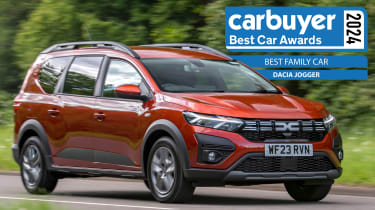
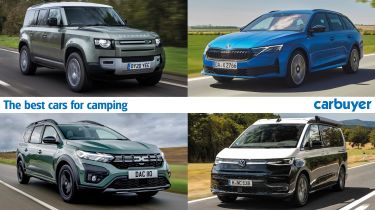
You’ve got your tent, sleeping bag, camping stove, clothes for every weather eventuality, a good set of hiking boots… but have you got the best car for camping?
A car is often still the best way to get you, your family and all your gear into the wilderness for a trip away – but some make it easier than others. Our experts have picked a handful of new cars that take the stress out of camping, whether you plan to sleep in the car itself or simply use it as the ultimate kit-hauling machine.
To find the most suitable options we’ve looked for a few key factors. All have to be spacious, with enough room for both passengers and luggage, but each of our choices has something special that elevates its abilities above that of a simple family hatchback, too.
We’ve also included a separate selection of the best camper vans on the market, aimed at those who prefer to sleep under metal rather than canvas. They offer everything you could need in one package, including your sleeping, cooking and storage space.
The Dacia Jogger is already one of the most useful cars on the market, with a vast interior, seven seats big enough for actual humans and plenty of equipment for not a lot of money. But there are ways to make it even more useful, with official camping accessory packs from the brand that let you effectively turn your car into a campsite.
For less than £2,000, a Sleep Pack can turn the back of the Jogger into a (cosy) double bed, with storage boxes below a mattress, and only a little more than £2,100 gets the Sleep Pack Ultimate, which includes a large fitted tent that also secures to the car, over the open tailgate. We’re not sure whether there’s enough space in the tent for all of those seven passengers, but it’s still a typically clever and unsurprisingly affordable solution from Dacia.
| Pros | Cons |
|
|
Unlike Dacia, Hyundai doesn’t offer any clever packs to turn your Ioniq 5 electric car into a compact campsite – and despite the car’s futuristic looks, you can’t simply press a button to transform it into a sci-fi luxury apartment either. But what the electric Ioniq 5 does have is a ‘V2L’ function. That stands for ‘Vehicle to Load’, which in a nutshell means you can use the car as a giant battery to power all kinds of devices.
Hyundai will sell you an adapter that plugs into the car’s charging port, that can supply 230V and 3.6kW of AC power. That’s more than enough to run a small refrigerator, some lighting for your camping plot, an e-bike, or anything else you’d usually use a noisy petrol generator to power. And of course, the Ioniq 5 can also tow up to a 1,600kg braked trailer, so you could still bring along a medium-sized caravan if you didn’t want to camp in a tent.
| Pros | Cons |
|
|
The Skoda Kodiaq is about as sensible as family cars get, so even if you didn’t go near the accessories list, it’d make a fine car for camping. It’s spacious, comfortable, and with raised ride height and the option of four-wheel drive, it won’t complain too much if you take it off the beaten track.
But combine Skoda’s ‘Simply Clever’ touches – such as an umbrella stored in a front door panel, and a boot luggage net to keep your gear in place – with useful accessories, and it gets even better. From simple touches like thick all-weather floor mats for front and rear-seat passengers, to a 15-litre cooling and warming box that straps between the rear seats, and even a portable coffee maker that accepts Nespresso-style pods, it’s easy to increase the Kodiaq’s range of abilities even further. It’s also a fantastic tow car for even large caravans, with a capacity of up to 2,000kg for the four-wheel drive diesel seven-seater.
| Pros | Cons |
|
|
It’s hardly a shock to find another Dacia model on this list. The brand goes above and beyond to ensure its cars are as versatile as they are affordable, and the latest Duster is no exception. It’s a spacious small SUV that punches far above its price tag, with a big boot for all your camping gear and the option of four-wheel drive for reaching more adventurous locations. Oh, and prices start from under £20,000, making it something of an SUV bargain.
Like the Jogger, the Duster is also available with the Sleep Pack, bringing a bed that folds out over the rear seats, black out blinds and storage boxes. The optional tailgate tent is up for grabs, too, if you fancy a bit more space to stretch your legs, while the factory-fitted roof rack will dramatically increase your cargo capacity for just £600. The Duster really is the affordable, go-anywhere camping machine, but if you’re up for some serious all-terrain adventures, then you might want to look at the…
| Pros | Cons |
|
|
The Defender name has long been synonymous with adventure, and the latest model lives up to that legacy. Plenty of large SUVs can tackle a green lane or an uneven campsite, but with a Land Rover Defender you know it’s been designed for much more challenging terrain than that. Pick a point on a map and as long as you can get to it legally (Land Rover owners’ clubs should be able to recommend great routes and camping spots), the car should be able to make it.
And of course, the Defender is inherently practical too. The side-hinged tailgate is less obstructive on a camping site than in a tight car park, and there’s huge space in the back. With the three-row, seven-seat Defender 130 you still get 389 litres of storage, but fold the rear rows flat and that expands to a massive 2,300 litres. There’s a hefty accessory list too, with everything from cooling/warming boxes to a Portable Rinse System for just over £300 – a small water tank and spray head for rinsing off muddy boots and camping equipment.
| Pros | Cons |
|
|
While the Defender is undeniably impressive, not everyone needs a camping vehicle capable of trekking across the Sahara and back. For most campers, all that’s needed is something safe, comfortable and with plenty of storage space – three boxes that the Skoda Octavia Estate ticks.
The regular Octavia hatchback won our Family Car of the Year award in 2025, and the Estate model simply sticks an even bigger boot on the back. It’s more than happy to swallow as many tents, cookers, and camping chairs you can throw at it, all while costing the same as a much less practical Volkswagen Golf.
No, there’s no four-wheel drive, and you miss out on the raised ride height of an SUV, but we expect most of your driving will be on the road for the most of the year, and that’s where the Octavia excels. Plus, with a 1,800kg tow capacity, it’ll have no trouble hauling a caravan if you decide to trade in your tent.
| Pros | Cons |
|
|
If those cars above just won’t cut it, then perhaps what you need is a camper van. They’re the automotive equivalent of ‘glamping’, often featuring small kitchenettes, sinks and sleeping space for up to four. Many car manufacturers now offer their own camper vans right from the factory, which can be bought at a normal dealership with a standard warranty.
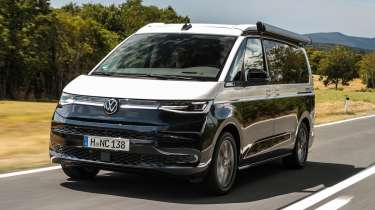
The Volkswagen California is one of the best-known camper vans around, with a heritage that stretches back to the first VW Microbuses of the 1950s. The latest model is based on the Volkswagen Multivan people-carrier, rather than the Transporter van, but that brings some benefits. For a start, it’s great to drive, with a solid lineup of petrol, diesel and plug-in hybrid engines that deliver a good balance of performance and economy.
Secondly, the cabin feels thoroughly modern up front, with digital displays and impressive built quality. The front seats swivel to face the rear, which is where the party really starts. All models get a small kitchen, while there’s sleeping space in the rear and in the pop-up roof. It’s a quality product, but that’s reflected in the price – you’ll need over £60,000 for even the most basic California, while top models command close to £80,000.

Ford’s rival to the California, the Transit Custom Nugget is a traditional van-based camper van with a host of unique touches inside. It’s built in collaboration with Westfalia – the brand famous for early VW Microbus conversions – and all models get a pop-up roof, an L-shaped kitchen area and a hot water boiler. There’s even an optional solar panel to help keep the battery topped up for off-grid adventures.
New for 2025 is the plug-in hybrid engine option, which joins the existing EcoBlue diesel unit. Ford has also introduced an Active trim level for the Nugget, which brings more rugged styling, durable interior fabrics and optional four-wheel drive.
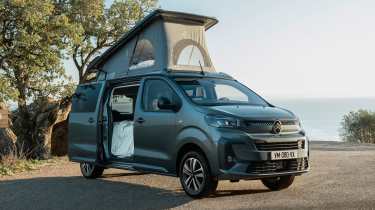
Like the Ford above, the Citroen Holidays is also based on a commercial van, but it comes in at a whopping £20,000 cheaper. You don’t miss out on camping kit, though – the Holidays comes with fully-fitted kitchen, storage and sleeping areas. The roof pops up to create additional sleeping space, while there’s a solar panel, removable toilet and outdoor shower included, too.
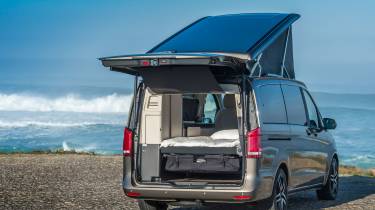
If the Kardashians were off for a weekend of camping in the Cotswolds, this would be their vehicle of choice. The regular Mercedes V-Class has always been the VIP’s MPV, so it’s no surprise that the Marco Polo variant wants to win over the premium end of the camper van market, too. Its interior has more in common with a luxury hotel suite than a two-man tent, but you have to pay for it – to the tune of nearly £90,000.
Much like the Venetian explorer himself, the V-Class Marco Polo is eager for an adventure. It has sleeping space for four, a small kitchenette, a fridge and a powerful diesel engine. Luxurious touches include the electrically opening roof and doors, leather upholstery, and yacht-inspired flooring. If you’re going to drive all 4,000 miles of the Silk Road, you’ll struggle to find a camper van as opulent as this Mercedes for the adventure.
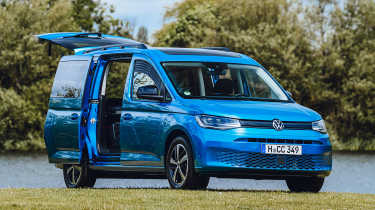
The Volkswagen Caddy California is the smaller sibling to the full-fat California above, but it still packs everything you need for your next weekend away in the wilderness. Based on the VW Caddy, the camper variant misses out on the pop-up roof of the models above, but there’s still room for two to sleep on the fold out bed inside. The pull-out mini kitchen allows for cooking under the cover of the tailgate, while the optional panoramic sunroof means you can stargaze from the comfort of your bed.
Here is a list of the six best cars for camping above with their starting price and Carbuyer score.
| Best car for camping | Make and model | Priced from | Carbuyer rating (out of 5) |
| 1 | Dacia Jogger | £19,000 | 4.0 |
| 2 | Hyundai Ioniq 5 | £40,000 | 4.5 |
| 3 | Skoda Kodiaq | £38,000 | 4.3 |
| 4 | Dacia Duster | £19,000 | 4.2 |
| 5 | Land Rover Defender | £58,000 | 4.4 |
| 6 | Skoda Octavia Estate | £28,000 | 4.5 |


